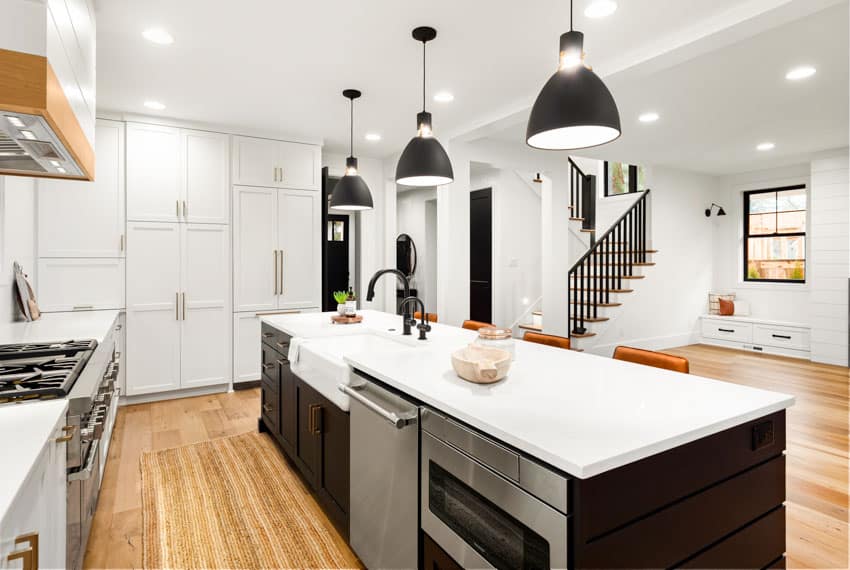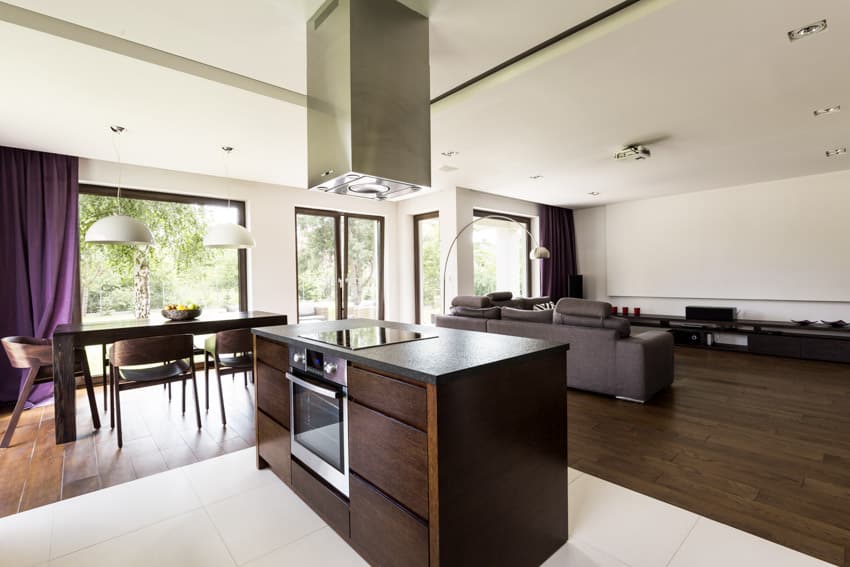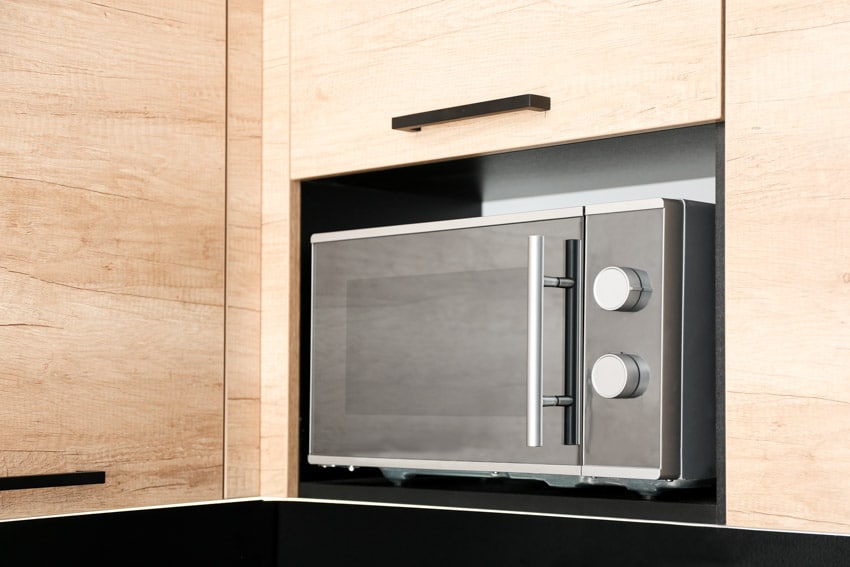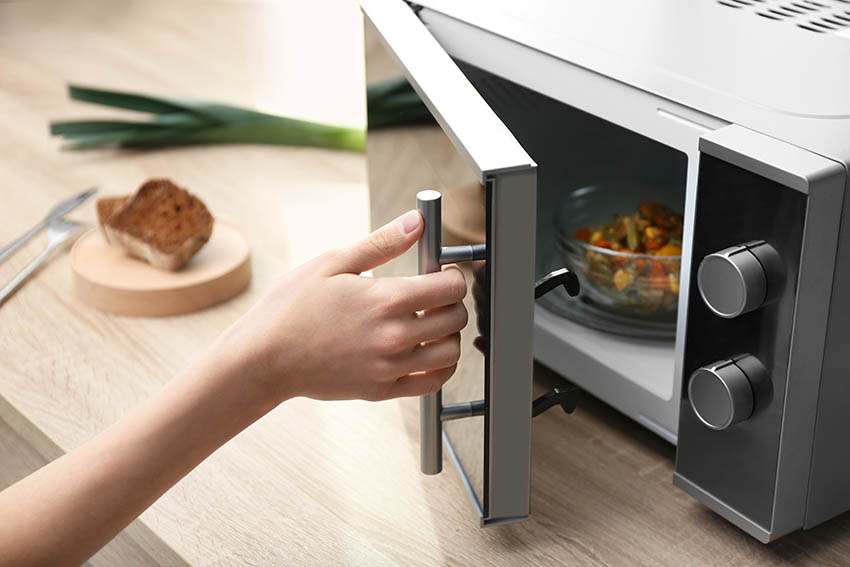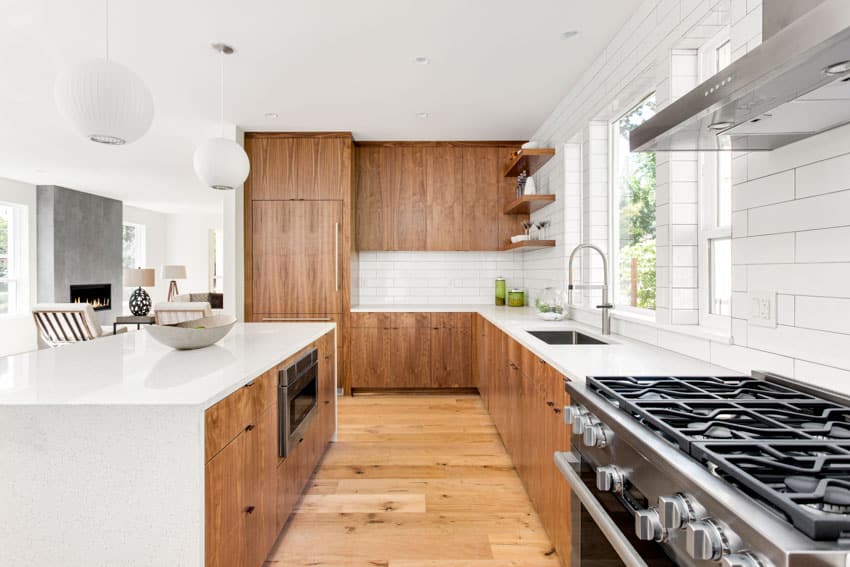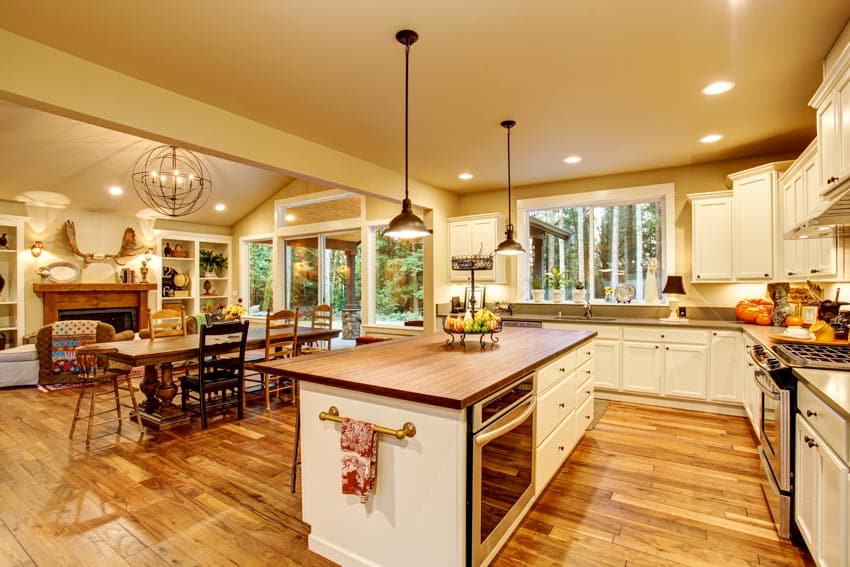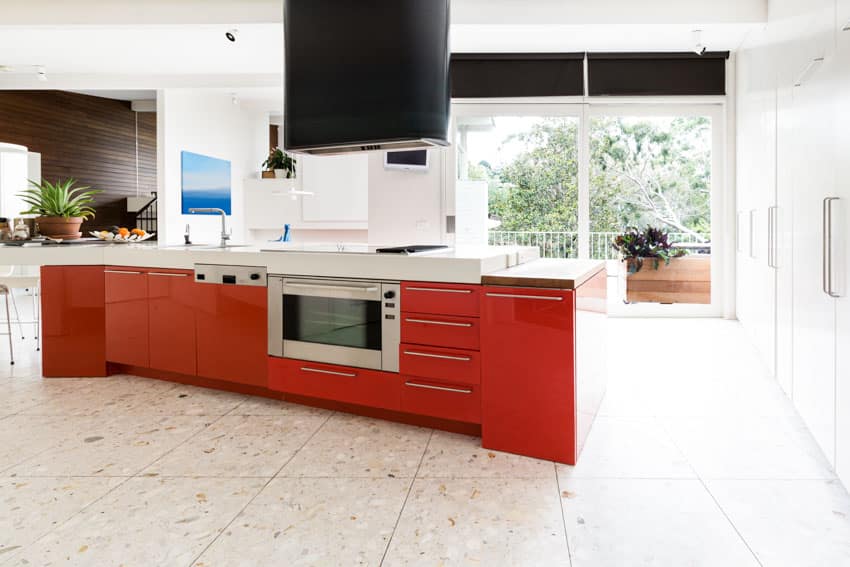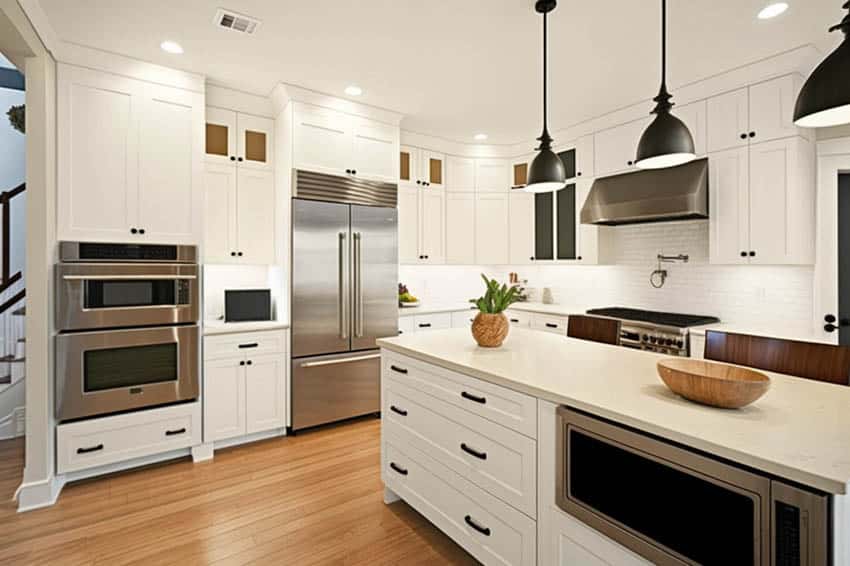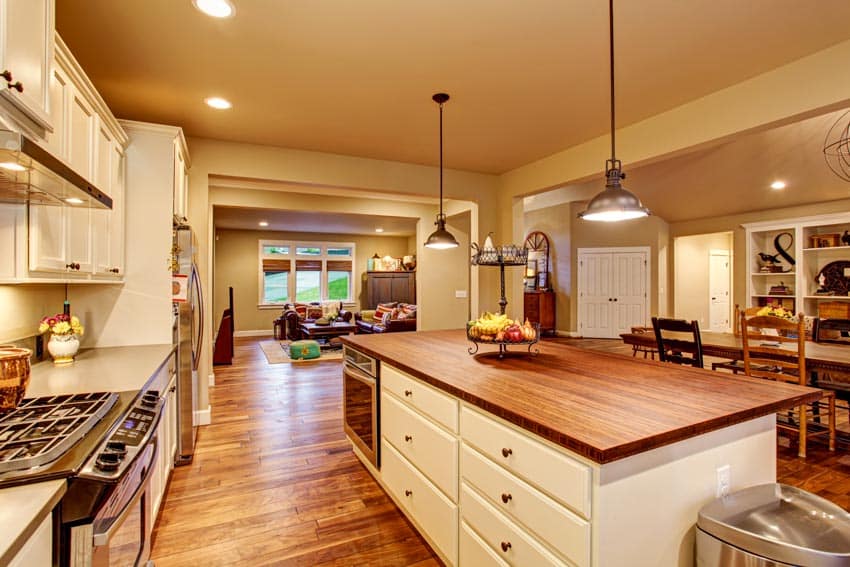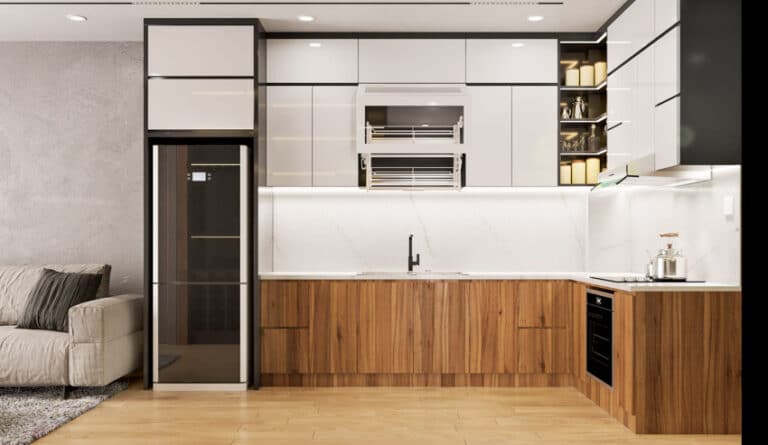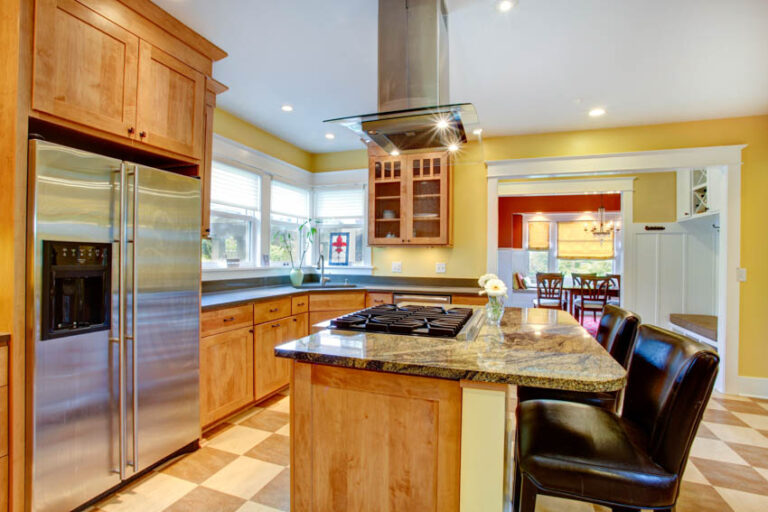Microwave In Island (Ideas & Pros and Cons)
This microwave in island guide features why it’s placed there, the different types, pros and cons, suggested kitchen island microwave sizes, and ideal height.
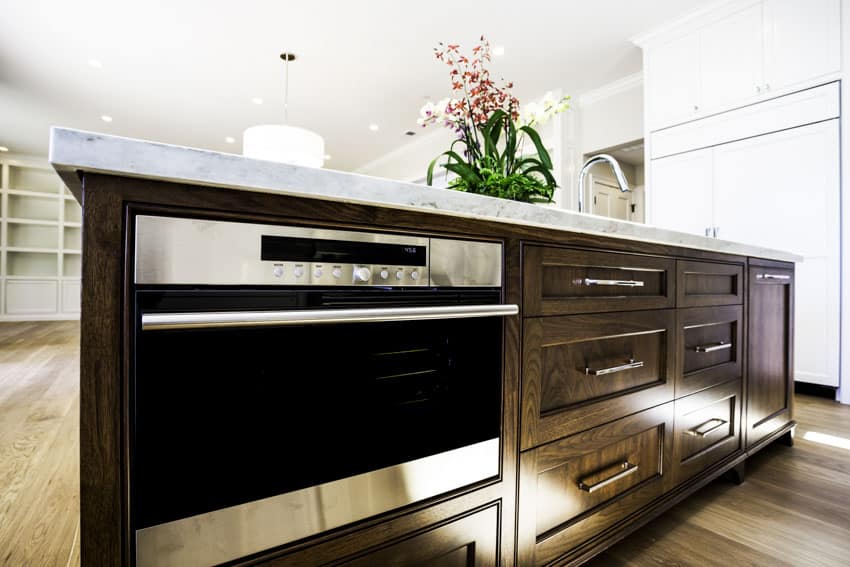
One of the staple appliances you will always find in the kitchen is a microwave oven. Known as a convenient appliance for cooking, a microwave oven is a tool used to heat food instantly. It will be very useful in the kitchen, but finding the right placement is important, especially considering it will heat up when in operation.
There are many areas in the kitchen where you can place the microwave oven in. One of the popular choices homeowners place these small appliances in is on the kitchen island. If this is also something you’re considering, explore what you can benefit from and experience when putting the appliance on it.
Why Do People Put Microwaves In Islands?
Many homeowners prefer putting their microwaves inside their kitchen island for a few good reasons. These are some of the top benefits of a kitchen island with microwave.
• Keeps the microwave oven out of sight: Some of these appliances won’t fit in your kitchen’s interior, and while some may do, some won’t work, so it would be better to keep them out of sight.
• Ventilation won’t be an issue: While you can always place them inside a cabinet, ventilation will always be a problem you must address, and you might need to take it out every time you use the appliance.
• Easier to reach: Keeping them in top cabinets may make the unit challenging to reach. Keeping them in low cabinets will make the appliance placement too low and inconvenient to access. This is the reason why placing it on top of the kitchen island is the solution for the perfect spot.
• Effective kitchen work triangle: Having a work triangle with the refrigerator, sink, and stove within close proximity is effective for meal preparation and cleanup. Having the appliance within this area is efficient and will cut down on unnecessary steps in the kitchen.
To better understand what’s in store for you when you choose to place the microwave oven on top of the kitchen island, you can explore the advantages and disadvantages that come along with this use and placement.
What Type Of Microwave Goes In An Island
The placement of your microwave oven is important not just to maximize the function of the said appliance but also to provide room for improvement and upgrade of the kitchen.
And if you’re leaning more toward placing the appliance on top of the kitchen island, there are specific types of microwaves compatible with that placement. Here are some microwave oven types worth considering.
Drawer Microwave
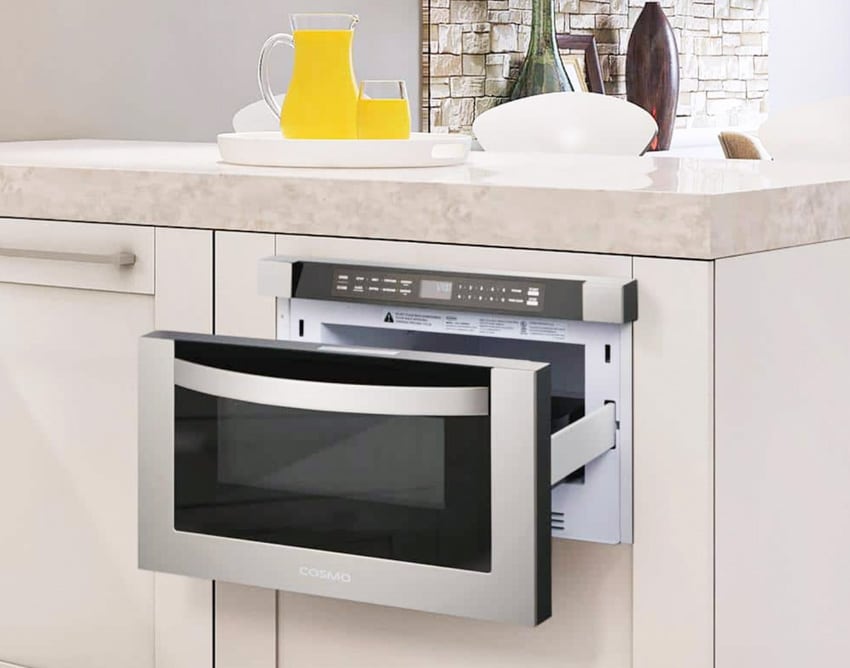
Another type of product compatible with a kitchen island is the drawer microwave. This type of oven is structured to be installed under the counter and on the kitchen island and lower cabinet.
And while it’s meant for a kitchen drawer, just as its name suggests, it is also a good option for kitchen island placement. Check out the advantages you’ll get with this type of cooking unit.
• Improved functionality: Compared to countertop and over-the-range microwaves this type has more available functions and features you can make use of.
• Showcases trendy and eye-catching aesthetics: The drawer heater is popular for being aesthetic and elegant in design.
• Allows for cleaner counter space: Its design is meant to be easier to access and placed at a lower height and cleanly and neatly installed.
With these benefits, though, there are also drawbacks that come with this choice. Drawer units are usually more expensive because they are considered niche products. In addition to that, you will also have fewer options if, by chance, it’s time to replace it.
Whether you go for a countertop or a drawer microwave, the decision is up to you. You can even choose the over-the-range microwave-oven, which will be a pretty unique option if you plan to install the oven on the kitchen island.
Microwave Drawer In Island
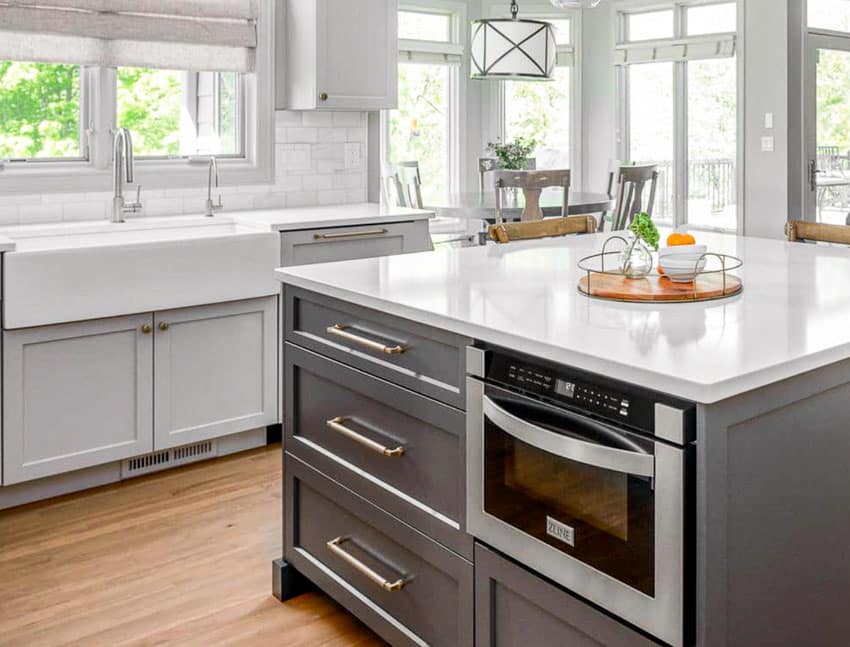
Having as much space on the countertops or kitchen island as much as possible is recommended since you get to have more space to work in. One way to free space on your countertop or island is by keeping kitchen appliances, tools, and utensils in drawers.
With this type of microwave oven, you can seamlessly keep the appliance in your kitchen drawer, which is out of sight when not needed and can easily be accessed when you need to use it.
If you choose a microwave drawer on the island, you can experience the following:
• Cleaner island and less clutter than might affect your productivity in the kitchen
• Produce a vibe of work and productivity
• Highly convenient and strategic installation
• Easy-to-fit design to your kitchen aesthetics
• Designs perfectly to fit under the kitchen island
• Elegant and trendy style of appliance
Kitchen Island With Built-In Microwave
If your kitchen island doesn’t have drawers or cabinets, you might need to customize and install a built-in microwave if you choose not to just lay the appliance on top of the island.
It is also a good option to keep the device out of sight without covering it up. You need to be strategic in installing the microwave oven, and a built-in one may be the perfect setup you’re looking for.
One big advantage of a kitchen island with a built-in appliance is that your cabinets remain free for other kitchen storage purposes. And since you have control over its placement, you can put it on the other side of the island, away from the cooking area, to have better foot traffic flow.
The convenience of this design depends on what part of the island you will integrate the appliance in. If integrated into the lower cabinets, the microwave may be too low and deep to reach.
Microwave Inside Island Cabinet
Another placement you can have for your microwave oven is in the island cabinet. Placing the unit in the cabinet will mean that the appliances will remain out of sight when not needed, leading to a cleaner and less cluttered kitchen island.
Once you choose to install your microwave oven in the island cabinet, make sure to customize the height where it will be convenient to reach and access.
You can also design the space to fit other essential small kitchen appliances to help free up the countertops. While customizing may come at a bit of a cost, the convenience may just be worth it.
Countertop Microwave Oven
Considered the traditional microwave oven, a countertop oven is designed to sit on any flat surface, whether it’s certain types of dining tables, countertops, or kitchen islands (As long as the location is near a power outlet).
Here are some advantages when choosing this type of appliance.
• Affordable in cost: This type is considered one of the most affordable.
• Excellent flexibility in placement: The design of this device can fit different types of space, at home or work. You can also use trim kits to install the oven properly and fill in any gaps available.
• Simple design: With its simple design, the installation will not be challenging if you choose the right location.
Microwave Installed In Island Pros and Cons
A microwave oven can have several benefits that make it a worthwhile consideration. Here are the pros and cons starting with the advantages.
Microwave Island Pros
Installing your microwave oven inside the kitchen island has positive and negative effects. While the negative ones will keep you from considering this plan, it’s the positive ones that can convince you otherwise. And here are some of the noteworthy advantages of installing the appliance in your kitchen island.
Showcases Modern & Sleek Design: Depending on your chosen type, it can be a wonderful addition to your kitchen aesthetics or something you should consider hiding.
Whichever your choice may be, both plans can be accommodated on the kitchen island and can showcase a clean and sleek style that features a uniform and streamlined look you would want your kitchen to have.
Highly Functional: An in-island cooking appliance is usually high-end and offers a wide variety of features, including the following:
• Soft-close doors
• Ergonomic buttons
• Secured locks
These features alone make the appliance more appealing to own and convenient to install. It also increases its functionality since while the oven is on the kitchen island operating, you can also cook simultaneously in the cooking area.
Extremely Accessible: A unit in the kitchen island is a more accessible appliance, especially with its location since the appliance will be located at the center of the room.
The placement of the microwave oven can be used even by shorter persons and even those who are using a wheelchair since they won’t need to reach over the cabinet to use this appliance.
Besides this, it is also a good option for people suffering from back problems since you won’t have to lift the appliance to another location to use it.
This placement can also accommodate high foot traffic, with people using the cooking area and the oven simultaneously without ease and bumping with each other.
Offers More Countertop Space: If you choose a microwave in the island, one of the possibilities you can enjoy is more counter space to work on. This will be possible if the appliance is installed in the drawer in the island or has its own built-in cocoon in the island. These locations of the device will ensure that all of the counter space is available for use.
Having more counter space also means that the area will be clean and have less clutter, with the appliance being installed out of sight in the drawer or cabinet.
Delivers Better Ventilation: One thing you can do to improve the ventilation in the kitchen is to install a vent hood. But this option is only highly recommended if you have an over-the-range microwave oven.
With an island microwave, you can be sure it will operate with excellent ventilation. This goes the same way with a unit installed in cabinets. You can add an exhaust fan or range hood above the microwave (whether in the island or cabinet) to help with the ventilation.
Safer Option To Consider: A heating appliance that can melt chocolates and other similar food may not be the safest thing you can use so installing it in the right place is necessary. And yes, one of the safest places you can put the microwave oven is the kitchen island.
With the oven device in the kitchen island, your cooking area becomes freer. There will be no chance of you bumping into the appliance as you busy yourself cooking. This is especially important if someone else is using the microwave while you’re cooking.
Microwave Within Island Cons
With all of these benefits, there are also several drawbacks in choosing this placement for your microwave, including the following:
High-Cost: Installing this appliance in the island is costly because it is customized compared to the other option of laying the appliance on top of the counter or storing it in a drawer or cabinet.
With a built-in microwave in the kitchen island, you will be set back around an average of $2,650 (with the range of $290 to $5,000), depending on the type and quality of the product, as well as the installation and construction required in your kitchen cabinet to accommodate the appliance.
Accessibility Issues: While accessibility is one of the advantages of a small cooking appliance on an island, it can also be a disadvantage. It can be a double-edged sword, particularly for tall people who would have to bend to use the appliance.
Difficult to Clean: Cleaning the microwave in the kitchen island will require you to bend and crouch down to access the area (The same challenge for the accessibility of tall people). Scrubbing while crouched down can be painful for your back.
More Complex Installation: Installation for a microwave in the island will require assistance since you have to get precise measurements of the appliance’s dimensions, as well as need to work on the electrical outlets and wiring.
Features Fewer Options: Once your current device breaks down, it will be difficult to find a replacement since the appliance is built into the island itself. It won’t be a problem if you have no issue installing and building one again.
Dangerous for Children: Since the microwave oven is installed in the lower part of the kitchen island, it is also easily accessible by kids, which can be extremely dangerous. You kids can play with the unit and put things inside and press buttons that can eventually start a fire.
While some microwave ovens have door locks, if yours does not have one, then get a control lock to help you secure the appliance.
Difficult To Watch Food As They Cook: If you’re cooking and heating something in simultaneously, it will be difficult to simultaneously watch over both since the location of the microwave is pretty low and out of reach from the cooking area.
What Size Microwave Goes In A Kitchen Island
Considering a microwave in your kitchen island, its dimension is one of the most important aspects you should know about.
Regarding sizes, here are the standard microwave sizes you might come across.
| Aspects/Dimensions | Compact/Small Microwave | Standard/Large Microwave |
| Capacity | 0.5 to 0.9 cubic feet | 1.0 to 2.2 cubic feet |
| Width | 15 to 19 inches | 21 to 25 inches (27 to 30*) |
| Height | 10 to 11 inches | 12 to 15 inches |
| Depth (Open Door) | 12 to 16 inches | 16 to 20 inches |
| Depth (Close Door) | 23 to 30 inches | 34 to 39 inches |
*with a trim kit
Microwave Built-In to Island Design Tips
We asked architect and designer Ellen Siloy her favorite tips for installing a microwave in a kitchen island, and here’s what she shared:
Install a pull-out shelf for easy access. A pull-out shelf will easily slide out the appliance when needed and slid back when not needed.
Consider a warming drawer. A warming drawer can be installed beneath the device to keep the food warm. The warming drawer comes in various designs, and the temperature can be adjusted. Though this can be an additional cost, it is a great investment, especially when receiving a lot of guests.
Maximize space further with a custom storage solution. For smaller kitchens, a custom storage solution can help ensure that space is not wasted, and it is an opportunity to create storage compartments along the built-in shell of the appliance.
Use a power board for ease of use and safety. Also known as a power strip or extension block, this device has multiple power outlets, allowing multiple electrical devices to be plugged into one area.
The power board has a long cord with several outlets placed along it. Typically, the power board will have a built-in surge protector that helps protect electronic devices, especially a microwave oven, as the appliance can easily be damaged with fluctuating voltages.
These power surges or spikes are usually caused by lightning, damaged transformer, or other electrical disturbances.
Caution: Though the power board is great in wire management, plug a portable microwave oven into a power strip that can handle the amperage. If unsure, best to plug the device into a dedicated electrical circuit.
Add Lighting. Illuminating the area above the device on the island makes it easier and safer when placing and getting food. Add a task light or install under-cabinet lighting.
Conveniently hide away the appliance with cabinet door panels. For a seamless look, consider installing cabinet panels to hide the unit when not in use. This will also create additional countertop space.
Use a Trim Kit. A trim kit can help the microwave blend seamlessly into your kitchen design. It’s important to choose the right size and model of trim kit to ensure a proper fit.
Locate in an accessible but won’t disrupt traffic flow. Consider the location of the appliance within the island, which should be easily accessible from all sides of the island and should not impede traffic flow. Furthermore, it’s also important to ensure the device is not placed too close to other appliances or the sink to avoid potential damage from splashing water.
Assign enough space for ventilation. Proper ventilation is essential for any built-in cooking appliance. Ensure adequate space around the unit for air to circulate and that the venting is installed correctly to avoid overheating or damage.
Consider placing a child lock and other safety features. As the device is positioned in the lower cabinets, it can be easily reached by children or pets. Be sure to install child lock safety features to prevent accidents.
Update user experience with smart and automated systems. Smart technology is also being integrated into built-in microwaves, with features such as voice control and wireless connectivity becoming increasingly popular. This allows for greater convenience and control and the ability to monitor cooking times and adjust settings remotely.
Are Microwaves Placed in Islands Too Low
Microwaves in islands can pose a usability problem if you install the appliance and integrate it too low in the kitchen island. A low placement is one of the reasons why some homeowners find this option undesirable due to the need to crouch down to use the microwave oven.
From a usability standpoint, a cooking appliance closer to countertop eye level is more desirable. If you’re an active cook and prefer multitasking in cooking, a low position will be a bit challenging to use. You will be required to bend down and then stand up again towards the cooking area to deal with just seeing and reaching the food currently cooking.
An alternative to this is to install a microwave drawer, which will have a lower profile and may be able to be installed higher in the island cabinet. One of the downsides of using a drawer style is they are generally much harder to keep clean.
Can You Put A Countertop Microwave On An Island?
Yes, you can put a countertop microwave oven on an island because this type is what it is structured for in the first place. This traditional type of portable oven is easy to place in the kitchen, but it also takes up too much counter space that if you like moving freely while preparing and cooking food, this might hinder you.
You can use a countertop unit and place it on an island as long as there is a power outlet that the appliance can use.
The caveat to this comes down to how it looks. Does a medium-sized appliance like a portable microwave stand out like a sore thumb sitting on the middle of your island counter?
If you have a two-tier or higher level breakfast bar-style island, this small appliance will probably look better than if it’s all alone on a single level countertop. It all comes down to personal preference and if you like how it looks there.
However, if you’re talking about building it into the island itself, most models and designs of countertop microwave ovens are not practical to be used for the customized island cabinet.
You can always ask a professional for advice on using countertop microwaves and recommendations on what other options you can explore.
See more related content in our article about steam oven vs. microwave on this page.

